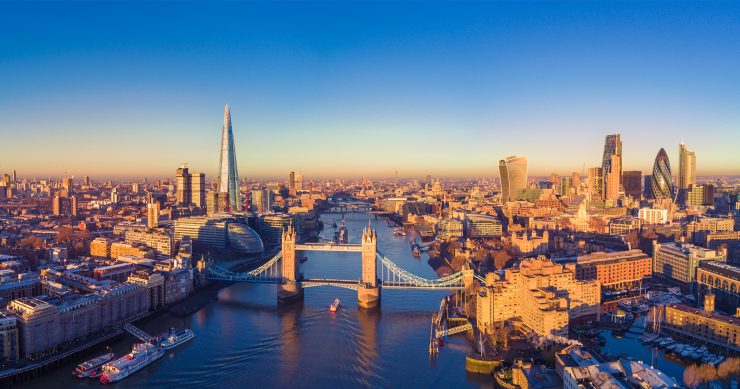The UK Hydrogen Strategy: pathway to a hydrogen (industrial) revolution? – Dr. Julio C. Garcia-Navarro.
One of my main activities is identifying who the players are in the chessboard of the hydrogen economy; I have written about Chile, the Sahara Desert, and the Netherlands. In the article about the Netherlands, I also mentioned that one of the most active countries in the area of hydrogen is the UK, so I will take this opportunity to talk about the British hydrogen strategy a bit more in detail. I had the pleasure to read the UK Hydrogen Strategy (you can find it here) that came out this month.
Unlike other national strategies where the strategy is published first and the actions follow suit, the UK has a different approach: they have had projects running for the past years about topic such as hydrogen blending and hydrogen for homes. The UK Hydrogen strategy creates a bridge between these projects and the rest of their ambitions across the value chain, where funding is pledged and goals are set for the short- and long-terms.
In the following paragraphs I will make a breakdown of what the UK Hydrogen strategy shows us.
🔥 What about we co-host a webinar? Let's educate, captivate, and convert the hydrogen economy!
Hydrogen Central is the global go-to online magazine for the hydrogen economy, we can help you host impactful webinars that become a global reference on your topic and are an evergreen source of leads. Click here to request more details
The goals
The goals are straightforward:
- Renewable and zero-carbon energy production:
- 40 GW offshore wind by 2030
- Nuclear power, both large-scale and small-scale
- Hydrogen production:
- 5 GW by 2030 (green + blue)
- Funding:
- GBP 240 million for co-investment in production capacity
- (Up to) GBP 1 billion their Net Zero Innovation Portfolio fund, which they mention considers hydrogen as a key priority area for low-carbon technologies towards net zero
- (Up to) GBP 315 million Industrial Energy Transformation Fund, a fund to support fuel switching to hydrogen in industry
- Hydrogen transport:
- It is undecided if they will go the blending route (20%) or the 100% route and they are investigating both pathways.
When it comes to the color of hydrogen, the UK has made it clear that they will follow a ‘twin track’ i.e., they will pursue the production of both green and blue hydrogen. This may come across as a bit controversial, especially since discussions about the ‘greenness’ of blue hydrogen were sparked by a particular scientific article that gained traction recently because of the affiliation of their authors (Cornell and Stanford Universities) as well as their findings. I will not delve into the details of the paper, but I can say that such publications kindle the fire of doubts some people (including policy makers and industrial stakeholders) already had about the suitability of blue hydrogen in a low-carbon economy.
Since one of the main resources needed for geological carbon storage is having the right subsurface conditions and the UK seems to have them in abundance (or at least at a sufficient scale), it appears that blue hydrogen is less a no-brainer to them than to other countries. I for one praise the strategy of maximizing the use of local (geological) resources to ease the transition to a world where carbon is no longer emitted.
UK Hydrogen Strategy – The milestones
Setting milestones in projects is often a difficult task (even when there is a work breakdown structure); setting them when there is no concrete project yet is outright ambitious. Nonetheless, the UK has laid out the following milestones in their hydrogen strategy; I have put in a timeline in the figure below.

To ensure that the milestones for 2030 and beyond are reached, it is critical that the pathway between now and 2030 show that there is a concrete idea of the steps to be taken. One phrase I heard in a recent webinar that stuck in my head is “2025 is tomorrow” and I think this is especially relevant for the UK given the ambitions laid out towards 2030 (that by extrapolation we can say is basically the day after tomorrow). What will happen between now and 2030 in the UK around the topic of hydrogen? Below is a figure that showcases the roadmap to 2030 according to their hydrogen strategy.

The expertise and ongoing activities
As I mentioned earlier, the UK has already a portfolio of hydrogen projects. Below is a table where I summarized the projects mentioned in the UK Hydrogen Strategy as well as the few projects I am aware of. The full list of commitments are on pages 111-115 of the of the UK Hydrogen Strategy.
| Topic | Projects |
| Hydrogen production | Gigastack (electrolysis), Dolphyn FLOW (green hydrogen), Acorn Project (blue hydrogen) |
| Hydrogen storage | SSE Thermal & Equinor hydrogen storage facility (geological storage) |
| Hydrogen transport | HyDeploy & H21 (distribution grid), FutureGrid (transmission grid) |
| Hydrogen utilization | Hy4Heat & H100 Fife (hydrogen for homes), Holyhead Hydrogen Hub (heavy duty transport), Project Union (connection of industrial clusters) |
| Sector coupling | The Orkney Islands projects e.g., BIG HIT (actually a Hydrogen Valley project), the Aberdeen Hydrogen Hub initiative |
One particular statement from the UK Hydrogen Strategy is that they don’t believe there will be a mature international hydrogen market (including overseas trade of hydrogen) by 2030, meaning that their primary focus is to produce hydrogen locally. This is a bit contrary to statements from countries such as Germany, where they recognize that the vast majority of their foreseen hydrogen consumption will have to be imported (even on the short term). I tend to agree with the UK on this topic, but I would find it a pleasant surprise if transpacific hydrogen trading i.e., between Australia and Japan, Korea, and China, were to be up and running by 2030.
With clear-cut goals and ambitious milestones, the UK have published their Hydrogen Strategy where they aim at having 5 GW of low-carbon hydrogen production by 2030 and a net zero economy by 2050. This is accompanied by a world-leading number of projects where the UK is researching the complete hydrogen value chain in an effort to develop a solid national hydrogen economy in the near future.
Dr. Julio C. Garcia-Navarro
Final words – UK Hydrogen Strategy
The main question that remains is: will the UK be able to create a hydrogen economy? To me it is clear that, even if the low-carbon hydrogen technologies are not at a stage of large-scale commercialization yet, the UK has an ambitious yet realistic plan. While these times are certainly different from the 1850’s, I think that past experience of British innovation and entrepreneurship led to a worldwide revolution (i.e., the Industrial Revolution) that sent out ripples even to this day. I think that the groundwork laid by Lord Kelvin and James Watt will continue to be developed by modern British leaders to set the pace for a Hydrogen Revolution all over the world.
READ the latest news shaping the hydrogen market at Hydrogen Central
About the author
Dr. Julio C. Garcia-Navarro is a Hydrogen Project Coordinator at New Energy Coalition. He has worked in the hydrogen industry for nearly a decade, on topics such as hydrogen electrolysis, compression, and transportation. Besides hydrogen, he is passionate about Renewable Energy Systems and the Internet of Things.
Copyright © Hydrogen Central. All Rights Reserved.









1 comment